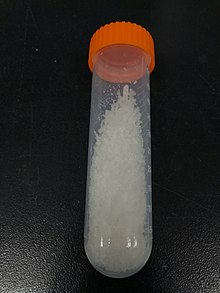Loading AI tools
Chemical compound From Wikipedia, the free encyclopedia
Europium(III) nitrate is an inorganic compound with the formula Eu(NO3)3·x(H2O). The hexahydrate is a common salt. It forms colorless hygroscopic crystals.
 | |
| Names | |
|---|---|
| IUPAC name
Europium trinitrate | |
| Identifiers | |
| |
3D model (JSmol) |
|
| ChemSpider | |
| ECHA InfoCard | 100.030.333 |
PubChem CID |
|
CompTox Dashboard (EPA) |
|
| |
| |
| Properties | |
| Eu(NO3)3 | |
| Molar mass | 337.985 g/mol 446.081 g/mol (hexahydrate) |
| Melting point | 65[1] °C (149 °F; 338 K) (hexahydrate) decomposes |
| Soluble | |
| Hazards | |
| GHS labelling: | |
  | |
| Warning | |
| H272, H315, H319, H335 | |
| P210, P220, P221, P261, P264, P271, P280, P302+P352, P304+P340, P305+P351+P338, P312, P321, P332+P313, P337+P313, P362, P370+P378, P403+P233, P405, P501 | |
| Related compounds | |
Other anions |
Europium(III) phosphate Europium(III) arsenate |
Other cations |
Samarium(III) nitrate Gadolinium(III) nitrate |
Related compounds |
Europium(II) nitrate Europium(III) oxide |
Except where otherwise noted, data are given for materials in their standard state (at 25 °C [77 °F], 100 kPa).
| |

The salt is usually obtained by dissolving europium(III) oxide (Eu2O3) in nitric acid produces europium(III) nitrate.[2]
Like all trinitates of the lanthanides, dilute (<0.01 M) solutions of consists of the aquo complex [Eu(H2O)x]3+ where x = 8 or 9. At higher concentrations, the binding of nitrate to Eu is observed.[3]
Europium(III) nitrate reacts with anions and other Lewis bases to form complexes. For example, with 1,3,5-trimesic acid, europium metal-organic framework, a coordination polymer, under hydrothermal conditions.[4]
Seamless Wikipedia browsing. On steroids.
Every time you click a link to Wikipedia, Wiktionary or Wikiquote in your browser's search results, it will show the modern Wikiwand interface.
Wikiwand extension is a five stars, simple, with minimum permission required to keep your browsing private, safe and transparent.